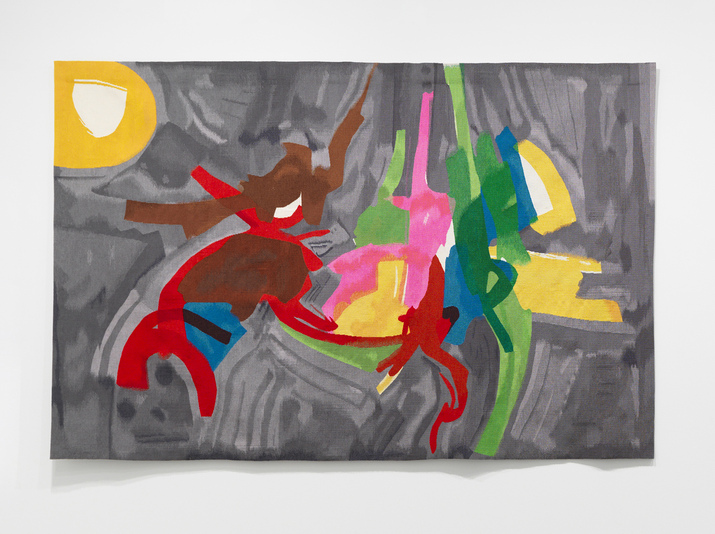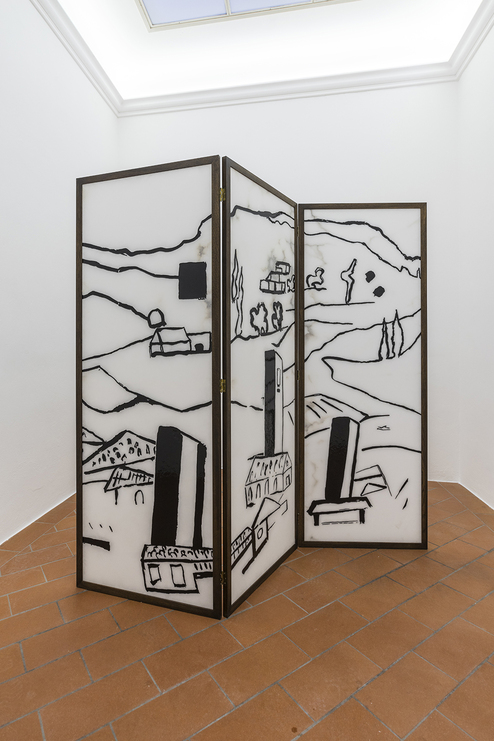-
From Current Issue
-
- Editor’s Letter Fire in the Heart
- Reviews I Gusti Ayu Kadek Murniasih
- Reviews 11th Seoul Mediacity Biennale: “One Escape at a Time”
- Dispatch Networked China
- One on One Monira Al Qadiri on Yukio Mishima
- Essays The rise of independent art spaces in pandemic-era Shanghai
- Features Tuan Andrew Nguyen
- Table of Contents
- Web Exclusives
- Archive
- Subscribe

R
E
V N
E
X
T
Installation view of ETEL ADNAN’s “Déjeuner au Soleil” at Galleria Continua, San Gimignano, 2017–18. Courtesy the artist and Galleria Continua.
Etel Adnan’s exhibition “Déjeuner au Soleil” at Galleria Continua in San Gimignano offered a concise but thoughtful overview of the artist’s career, featuring 11 works in painting, drawing, tapestry and sculpture, spanning from 1968 to the present day.
Novelist, poetess and artist Etel Adnan is a seminal figure of contemporary culture. Born in Beirut in 1925 to a Greek mother and a Syrian father, she spent her youth in Lebanon, later moving to Paris to study philosophy at Sorbonne University. She completed her postgraduate studies at the University of California, Berkeley, and Harvard, and then taught at the Dominican College in San Raphael, California, from 1958 to 1972, where she became the head of the university’s art department, before she returned to Beirut. An authoritative voice of feminism and pacifism, Adnan became renowned as a writer of politically charged novels, in which she incisively described the grief and horror of the Lebanese civil war that began in 1975 and lasted until 1990. Though Adnan started painting in 1959, her visual art did not achieve acclaim until 2012, when her participation in Documenta 13 in Kassel spurred a string of shows celebrating her art worldwide.
In contrast with her writings, Adnan’s paintings of landscapes or abstract compositions are joyful and serene, tinged with a deep attachment to the many places where she has lived. The artist usually paints on an intimate scale, and her compositions are formed by blocks of pure, brilliant colors, often directly applied onto the canvas from the tube.
The earliest dated painting on show was an untitled work from 1968 that features a cluster of irregular, overlapping shapes in blue, yellow, ocher, red and green, layered with sweeping strokes of the palette knife over a background of pink, gray and cream. The painting could be read as abstraction, but its composition and palette, which recall the basic colors of nature, convey a vague feeling of a place, not unlike a blurred memory.
Similar tints and composition appear in a later painting, another untitled work that was made in 1983, where the artist’s intention to present a landscape is clear. The picture shows a dark blue and green peak, set against a pink and indigo sky, towering over a patchwork of curvy fields in earthy, warm hues. In the foreground, blocky blue and azure shapes suggest a tranquil sea. This particular painting refers to a place that has a deep meaning for Adnan: Mount Tamalpais, a landmark in California that is near her home in Sausalito, where the artist first started experimenting with the visual arts, making thousands of drawings of the mountain. In 1986, she even wrote an ode to her muse, entitled Journey to Mount Tamalpais, which touches upon the relationship between nature and art.
Two large-scale tapestries, Lumière Blanche and Déjeuner au Soleil (both 2016), bustle with movement, and feature imprecise, interweaving patterns woven in radiantly bright colors over a textured background in shades of gray. When living in America, Adnan missed the Lebanese custom of having rugs at home. She started making drawings for tapestries in the 1960s, attending courses on experimental weaving as a means to channel her creativity. With unbridled imagination, Adnan injects a refreshing playfulness into a medium that is part of her cultural heritage.
A separate room hosted San Gimignano 4 (2014), one work in a recently produced series of large alabaster folding screens. The idea of making screens developed from Adnan’s signature leporellos, booklets consisting of a single strip of paper pleated with concertina folds, which the artist decorates with painting, writing and poetry. On the screen’s opalescent marble, we see the Italian city’s medieval churches and towers among the hilly countryside, beautifully rendered in resin—a testament to Adnan’s ability to relay the mood of a place even when only using black lines and simple solids.
With a small selection of works, “Déjeuner au Soleil” effectively demonstrated Adnan’s consistent capacity to communicate emphatically through plain forms and the emotive use of color. Perhaps her landscapes were developed as sanctuaries of peaceful respite from the turmoil that Adnan had witnessed and describes in her writings. Whatever traumas may be behind her art, Adnan’s work provides warmth and joy that transcends heartache and woe.
Etel Adnan’s “Déjeuner au Soleil” is on view at Galleria Continua, San Gimignano, until January 6, 2017.
To read more of ArtAsiaPacific’s articles, visit our Digital Library.







